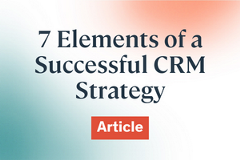
The Latest Hospital Digital Marketing Articles
GreyMatters is your hospital digital marketing guide, with articles on hospital digital marketing best practices, trends, updates and more.
7 Elements of a Successful CRM Strategy in Healthcare
This article was provided by Actium and Hello Healthcare. 
While healthcare organizations are embracing customer relationship management (CRM) systems, the success of these systems depends on the adoption of a comprehensive CRM strategy. A well-thought-out CRM strategy involves seven essential elements that are necessary for healthcare organizations to maximize their success in deploying a CRM solution. These elements include defining goals, selecting the right CRM platform, creating a data-driven culture, fostering user adoption, tracking and measuring performance, leveraging automation, and continuing to evolve. By implementing a CRM strategy that takes into account all seven essential elements, healthcare organizations can ensure that they are getting the most out of their CRM system and achieving better patient outcomes.
This topic was discussed during a Hello Healthcare podcast interview featuring Chris Dufresne, VP of Digital Products and Marketing Technology at Allina Health, and Alan Tam, Chief Marketing Officer at Actium Health. Listen to the full episode to learn about misconceptions, pitfalls, and effectiveness of CRM technologies.
7 Key Elements:
- CRM adoption in healthcare starts with understanding the healthcare environment and the challenges that it faces. It’s important to understand the leadership, executive, and board level sentiment of adopting a CRM. If they don’t understand the value, start educating them. For example, streamlining operations, personalizing outreach, and improving patient outcomes are all meaningful goals for implementing a CRM.
- A good CRM must be tailored to the specific needs of a healthcare organization, taking into consideration areas such as patient care, operations, and compliance. Once you have executive buy-in and the challenges and needs of the healthcare organization are identified, the next step is to select a CRM system. You’ll want to find one that meets the organization's objectives, while providing the necessary tools and features to assist with the overall strategy.
- After selecting a CRM system, the organization must then define their operations and processes, incorporate the CRM program into any current systems, and teach personnel how to utilize the system. The implementation can be a lengthy process, but it is vital to set goals and keep making progress even if there are unexpected issues. It is essential to stay in contact with the relevant parties as goals and schedules are agreed upon.
- Be aware of potential issues and learnings when introducing a CRM. One of the primary concerns should be making sure the data is accurate and governed in the right way. Make it clear that you are not creating another Electronic Medical Record (EMR). Make sure to explain the desired outcome and capabilities of the CRM to key stakeholders.
- One of the many benefits of a CRM includes the ability to segment your audiences and better personalize outreach. Outreach to patients can include a variety of channels such as email, SMS/text, phone, etc. Don’t hesitate to ask your customers, "What method of communication would you prefer? Could we reach out to you via text or email?" That will help tailor communications to what the patient prefers.
- Communicate the value of a CRM to leadership by demonstrating how it can help reduce costs and improve operational efficiencies. Explain how the collection and analysis of patient data will enable the organization to make more informed decisions. Additionally, it can streamline communication with patients, enhancing the overall patient experience.
- Finally, continue to monitor and analyze the effectiveness of the CRM to ensure it meets the organization's goals and objectives. Iterate and find new ways to leverage the solution to make a greater impact. Measure outcomes and course correct as necessary.
CRM systems can help healthcare organizations optimize their operations, provide better care, and build stronger relationships with their customers. While the use of CRM is growing at an exponential pace, many healthcare organizations have yet to make the leap. One of the most effective ways to encourage healthcare organizations to adopt a CRM strategy is through healthcare-specific educational initiatives. The leaders interviewed in this article believe that healthcare-specific education initiatives are necessary to help foster awareness of the benefits of CRM within the healthcare community.
This interview took place at the Healthcare Internet Conference (HCIC), in partnership with Actium Health. HCIC is the premier conference for senior and executive digital health decision makers focusing on the business and transformation of healthcare. Learn more about the HCIC annual conference.
Watch the full interview below and subscribe to new episode releases at hellohealthcare.com.